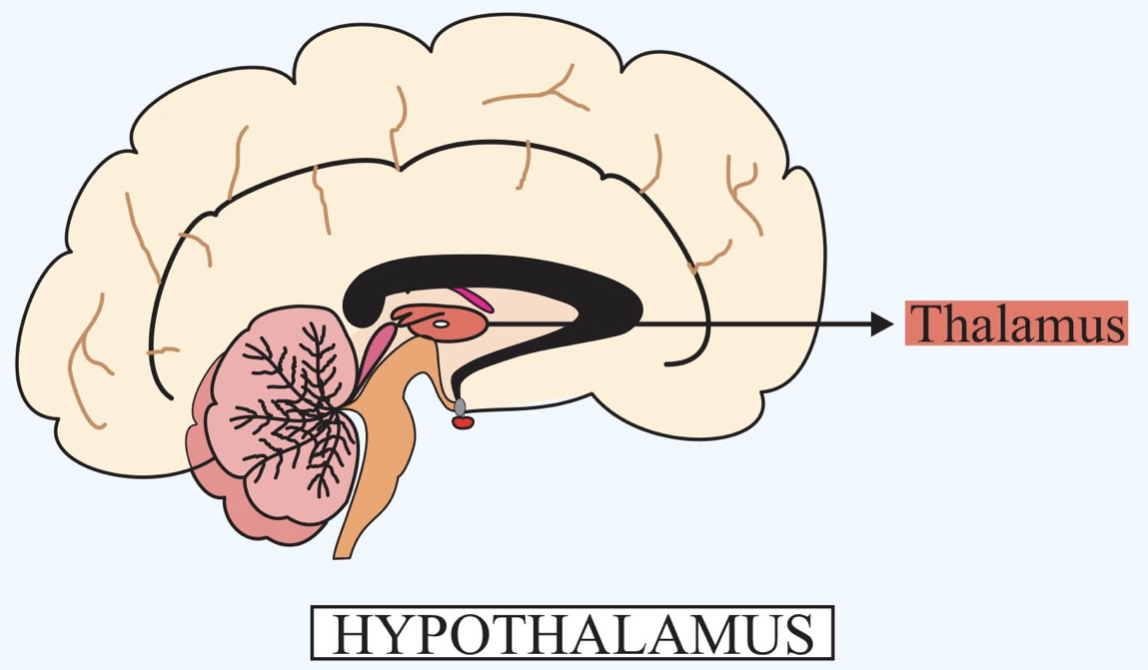
The coordinator between nervous and endocrine systems is
(a) Thalamus
(b) Hypothalamus
(c) Epithalamus
(d) Colliculus
Answer
561k+ views
Hint: The Coordinator between nervous and endocrine systems is located at the base of the diencephalon and participates in both neural as well as endocrine functioning. It controls the functioning of another endocrine gland to which it is connected by a stalk.
Complete answer:
The hypothalamus is considered as a neuroendocrine structure rather than a true endocrine gland. It is responsible for the maintenance of body temperature and thus behaves as a thermoregulation center. It controls sleeping patterns and wakefulness. It also behaves as a hunger, appetite, and satiety center to control the desire for food.

Its endocrine functions include the secretion of neurohormones which further control the secretions of anterior pituitary hormones. Hypothalamus bears neurosecretory cells and their secretion is called neurohormone. It synthesizes some hormones like oxytocin and ADH which is stored in the posterior pituitary gland and released upon proper signals. Thus, it is a perfect coordinator between nervous and endocrine systems.
Additional Information:
- Diencephalon which is a division of the forebrain and consists of three substructures namely the epithalamus, thalamus, and hypothalamus.
- Epithalamus is a non-nervous part that is fused with the pia mater of the brain. It synthesizes cerebrospinal fluid.
- Thalamus directs sensory impulses from the lower parts of the brain and spinal cord to appropriate parts of the cerebrum.
- Colliculi is located in the midbrain and is responsible for transmitting any sensory input into movement output.
- Oxytocin stimulates vigorous uterine contractions during childbirth. It is necessary to move the child out through the birth canal.
- ADH or Antidiuretic hormone released by the posterior pituitary increases the permeability of the distal convoluted tubules and collecting duct of the nephron located in the kidney.
So, the correct answer is ‘(b) Hypothalamus.’
Note:
- ADH is necessary to produce concentrated urine and thus prevent water loss from the body. It is also known as vasopressin.
- Oxytocin is also required after childbirth for the continuous production and secretion of milk from the mammary glands.
Complete answer:
The hypothalamus is considered as a neuroendocrine structure rather than a true endocrine gland. It is responsible for the maintenance of body temperature and thus behaves as a thermoregulation center. It controls sleeping patterns and wakefulness. It also behaves as a hunger, appetite, and satiety center to control the desire for food.

Its endocrine functions include the secretion of neurohormones which further control the secretions of anterior pituitary hormones. Hypothalamus bears neurosecretory cells and their secretion is called neurohormone. It synthesizes some hormones like oxytocin and ADH which is stored in the posterior pituitary gland and released upon proper signals. Thus, it is a perfect coordinator between nervous and endocrine systems.
Additional Information:
- Diencephalon which is a division of the forebrain and consists of three substructures namely the epithalamus, thalamus, and hypothalamus.
- Epithalamus is a non-nervous part that is fused with the pia mater of the brain. It synthesizes cerebrospinal fluid.
- Thalamus directs sensory impulses from the lower parts of the brain and spinal cord to appropriate parts of the cerebrum.
- Colliculi is located in the midbrain and is responsible for transmitting any sensory input into movement output.
- Oxytocin stimulates vigorous uterine contractions during childbirth. It is necessary to move the child out through the birth canal.
- ADH or Antidiuretic hormone released by the posterior pituitary increases the permeability of the distal convoluted tubules and collecting duct of the nephron located in the kidney.
So, the correct answer is ‘(b) Hypothalamus.’
Note:
- ADH is necessary to produce concentrated urine and thus prevent water loss from the body. It is also known as vasopressin.
- Oxytocin is also required after childbirth for the continuous production and secretion of milk from the mammary glands.
Recently Updated Pages
Why are manures considered better than fertilizers class 11 biology CBSE

Find the coordinates of the midpoint of the line segment class 11 maths CBSE

Distinguish between static friction limiting friction class 11 physics CBSE

The Chairman of the constituent Assembly was A Jawaharlal class 11 social science CBSE

The first National Commission on Labour NCL submitted class 11 social science CBSE

Number of all subshell of n + l 7 is A 4 B 5 C 6 D class 11 chemistry CBSE

Trending doubts
Differentiate between an exothermic and an endothermic class 11 chemistry CBSE

10 examples of friction in our daily life

One Metric ton is equal to kg A 10000 B 1000 C 100 class 11 physics CBSE

Difference Between Prokaryotic Cells and Eukaryotic Cells

1 Quintal is equal to a 110 kg b 10 kg c 100kg d 1000 class 11 physics CBSE

State the laws of reflection of light




